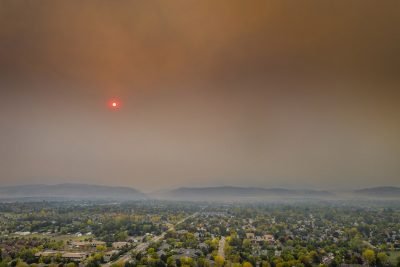
Wildfire Smoke Exposure Is a Risk Factor for Dementia
By Michael T. Lin, MD, PhD
Synopsis: In this large, open cohort study based on electronic health record data from 2009 to 2019 of dementia-free people older than 60 years of age, exposure to wildfire smoke resulted in an increased incidence of dementia later in life.
Source: Elser H, Frankland TB, Chen C, et al. Wildfire smoke exposure and incident dementia. JAMA Neurol. 2024; Nov 25:e244058. doi:10.1001/jamaneurol.2024.4058. [Online ahead of print].
Exposure to fine particulate matter less than 2.5 micrometers in diameter (PM2.5) is a recently recognized dementia risk.1 Wildfires can cause significant PM2.5 exposure and have increased worldwide because of climate change. Because wildfire and non-wildfire PM2.5 differ chemically and physically, it is unknown whether they confer similar dementia risk. Elser and colleagues addressed this question by examining electronic health record (EHR) data from Kaiser Permanente in Southern California (KPSC), where wildfires account for more than 70% of total PM2.5 exposure on poor air quality days.
The study was an open cohort study from Jan. 1, 2009, to Dec. 31, 2019, of all KPSC members at least 60 years of age living in a KPSC census tract and free of dementia at cohort entry. Wildfire and non-wildfire PM2.5 exposures were estimated for each census tract using data from monitoring systems such as the Environmental Protection Agency Air Quality System, the Gridded Surface Meteorological dataset, the National Oceanic and Atmospheric Administration Hazard Mapping System, and the California Department of Forestry and Fire Protection.
Daily estimates were used to calculate three-year rolling means, updated quarterly. All-cause dementia was identified using EHR codes for diagnoses including Alzheimer s disease, Lewy body disease, vascular dementia, and others. Individual-level covariates included age, sex, race and ethnicity, smoking status, relationship status, and need for an interpreter at any visit. Vascular risk factors, such as hypertension or high cholesterol, were not used as covariates because they were viewed as likely mediators for, rather than confounders of, an association between PM2.5 exposure and dementia.
Census tract-level covariates included population density and percentage living in poverty. A discrete-time approach pooled logistic regression was used to estimate the odds of dementia diagnosis associated with a 1 mcg/m3 increase in wildfire or non-wildfire PM2.5 concentrations.
There were 1,223,107 KPSC members eligible for inclusion, and 80,884 (6.6%) developed incident dementia. Over the study period, the median (interquartile range; IQR) three-year rolling average for wildfire PM2.5 exposure was 0.09 (0.05-0.16) mcg/m3, but for non-wildfire PM2.5 exposure it was 11.2 (9.6-12.4) mcg/m3, reflecting the intermittency of wildfires. A 1 mcg/m3 increase in wildfire PM2.5 exposure was associated with an odds ratio of 1.18 (95% confidence interval [CI], 1.03-1.34) for dementia, whereas for non-wildfire PM2.5, the odds ratio was only 1.01 (95% CI, 1.01-1.02).
For wildfire PM2.5 exposure, associations were even stronger in members younger than 75 years of age (OR, 1.73; 1.44-2.08), men (OR, 1.28; 1.05-1.56), and those living in high-poverty census tracts (OR, 1.30; 1.04-1.62). Racial minority subgroups also had higher odds of dementia with wildfire PM2.5 exposure, but CIs all included 1.0. However, this trend aligns with prior research showing that individual- and area-level social determinants compound the outcomes associated with environmental exposures.
This estimate of dementia risk with non-wildfire PM2.5 is in line with previous studies. It extends previous work by showing an even stronger risk increase with wildfire PM2.5 vs. non-wildfire PM2.5 (18% increase vs. 1% increase per 1 mcg/m3 increase). Possible reasons for increased toxicity of wildfire PM2.5 include generation by combustion of organic materials at much higher temperatures than for non-wildfire PM2.5, higher concentrations of oxidative and pro-inflammatory compounds, smaller particle size, and intermittent spikes of exposure to very high levels.
Commentary
Since the risk of dementia increases with age, it is somewhat counterintuitive that the strongest association of wildfire PM2.5 with the risk of dementia was found in members younger than 75 years of age. The authors speculated that younger members may have spent more time outdoors and had worse exposures, that older members most susceptible to wildfire PM2.5 may have died before cohort entry or dementia diagnosis, or that lower baseline risk of dementia at younger ages could contribute to higher effect estimates on a relative scale.
There still are quite a few unknowns, including the relevant exposure windows for PM2.5 in dementia pathogenesis, the best way to handle the intermittent spiking nature of wildfires and the most biologically relevant measure of exposure, whether specific dementia diagnoses are selectively affected, and whether individual behavior modifications (such as masking or limiting time spent outdoors) or social-level interventions (such as public health messaging or provision of clean air shelters) could mitigate dementia risk. However, this is a valuable study highlighting the neurologic importance of an exposure that is increasing in frequency as global temperatures rise.
Michael T. Lin, MD, PhD, is Associate Professor of Neurology and Neuroscience, Weill Cornell Medical College.
Reference
1. Livingston G, Huntley J, Liu KY, et al. Dementia prevention, intervention, and care: 2024 report of the Lancet standing commission. Lancet. 2024;404(10452):572-628.
In this large, open cohort study based on electronic health record data from 2009 to 2019 of dementia-free people older than 60 years of age, exposure to wildfire smoke resulted in an increased incidence of dementia later in life.
Subscribe Now for Access
You have reached your article limit for the month. We hope you found our articles both enjoyable and insightful. For information on new subscriptions, product trials, alternative billing arrangements or group and site discounts please call 800-688-2421. We look forward to having you as a long-term member of the Relias Media community.
